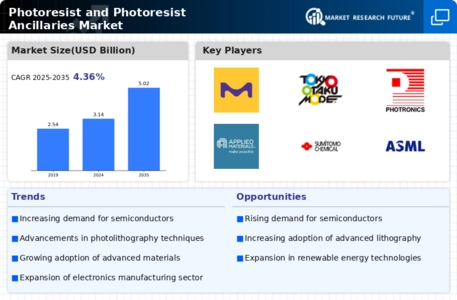Expansion of the Automotive Sector
The Global Photoresist and Photoresist Ancillaries Market Industry is witnessing growth due to the expansion of the automotive sector, particularly with the rise of electric vehicles. As automotive manufacturers increasingly incorporate advanced electronics into their vehicles, the demand for high-quality photoresist materials becomes paramount. These materials are essential for the production of intricate electronic components that enhance vehicle performance and safety. The automotive industry's shift towards electrification and automation is likely to drive the market further, as manufacturers seek reliable photoresist solutions to meet stringent quality standards. This trend indicates a robust future for the photoresist market, aligning with broader technological advancements.
Market Trends and Growth Projections
The Global Photoresist and Photoresist Ancillaries Market Industry is characterized by several key trends and growth projections. The market is anticipated to reach 3.14 USD Billion in 2024, with a compound annual growth rate of 4.36% expected from 2025 to 2035. This growth is driven by various factors, including technological advancements, increased demand for consumer electronics, and the expansion of renewable energy technologies. As the industry evolves, stakeholders are likely to focus on developing innovative photoresist solutions that cater to the changing needs of manufacturers across different sectors. The interplay of these trends suggests a dynamic and evolving market landscape.
Rising Demand for Consumer Electronics
The Global Photoresist and Photoresist Ancillaries Market Industry is significantly driven by the escalating demand for consumer electronics. With the proliferation of smartphones, tablets, and wearable devices, manufacturers are compelled to enhance their production capabilities. This trend is expected to contribute to the market's growth, with projections indicating a rise to 5.02 USD Billion by 2035. The need for high-performance chips necessitates the use of advanced photoresist materials, which are integral to the fabrication process. As consumer preferences evolve towards more sophisticated technology, the demand for innovative photoresist solutions is likely to intensify, further propelling market expansion.
Growth in Renewable Energy Technologies
The Global Photoresist and Photoresist Ancillaries Market Industry is also influenced by the growth of renewable energy technologies, particularly in solar energy applications. The increasing adoption of photovoltaic cells requires specialized photoresist materials for efficient production. As governments worldwide push for sustainable energy solutions, the demand for solar panels is expected to rise, thereby impacting the photoresist market positively. This trend aligns with the broader shift towards green technologies, potentially leading to a compound annual growth rate of 4.36% from 2025 to 2035. The integration of photoresist materials in renewable energy applications underscores their versatility and importance in emerging markets.
Regulatory Support for Semiconductor Industry
The Global Photoresist and Photoresist Ancillaries Market Industry benefits from regulatory support aimed at bolstering the semiconductor industry. Governments are increasingly recognizing the strategic importance of semiconductor manufacturing for economic growth and national security. Initiatives to provide funding and incentives for research and development in this sector are likely to stimulate demand for photoresist materials. As policies evolve to support domestic production capabilities, the market is expected to flourish, with a projected increase to 5.02 USD Billion by 2035. This regulatory environment fosters innovation and investment, ensuring a sustainable growth trajectory for the photoresist market.
Technological Advancements in Semiconductor Manufacturing
The Global Photoresist and Photoresist Ancillaries Market Industry is experiencing a surge due to rapid technological advancements in semiconductor manufacturing. Innovations in photolithography techniques, such as extreme ultraviolet lithography, are enhancing the precision and efficiency of chip production. This evolution is crucial as the demand for smaller, more powerful electronic devices increases. In 2024, the market is projected to reach 3.14 USD Billion, reflecting the industry's adaptation to cutting-edge technologies. As manufacturers strive to meet the growing needs of sectors like consumer electronics and automotive, the integration of advanced photoresist materials becomes essential for maintaining competitive advantage.



















